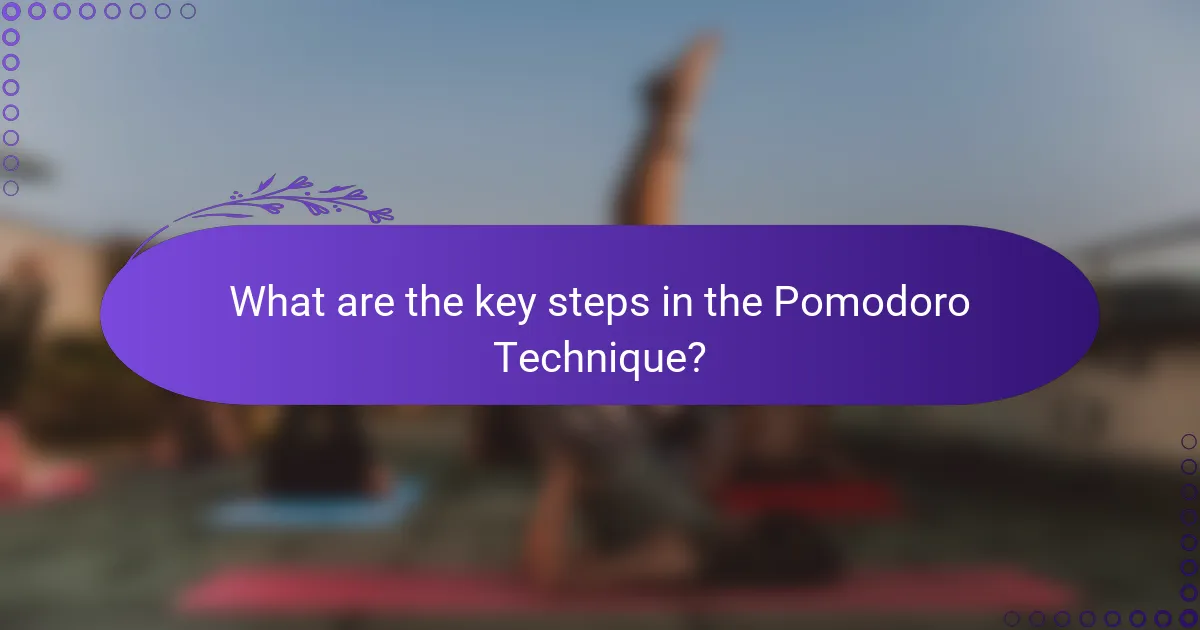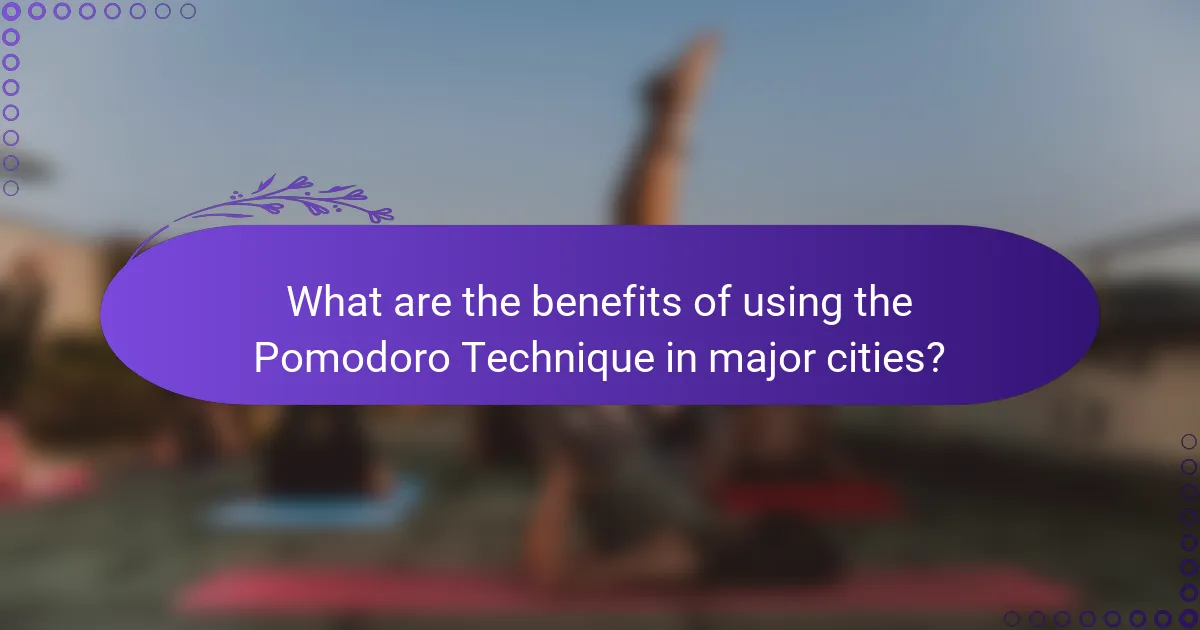The Pomodoro Technique is a time management method that improves focus and reduces stress by dividing work into intervals, typically lasting 25 minutes, followed by short breaks. This structured approach not only enhances productivity but also helps prevent mental fatigue, allowing for sustained concentration and mental clarity throughout the day.

How does the Pomodoro Technique improve focus?
The Pomodoro Technique enhances focus by breaking work into structured intervals, allowing for concentrated effort followed by short breaks. This method helps maintain high levels of productivity while reducing mental fatigue.
Structured work intervals
The Pomodoro Technique divides work into intervals, typically lasting 25 minutes, known as “Pomodoros.” After each interval, a short break of about 5 minutes is taken. This structure helps create a sense of urgency, encouraging individuals to work more efficiently.
After completing four Pomodoros, a longer break of 15 to 30 minutes is recommended. This cycle not only helps sustain focus but also allows the brain to rest and recharge, enhancing overall productivity.
Minimized distractions
By committing to focused work during each Pomodoro, distractions are minimized. The technique encourages users to set boundaries, such as silencing notifications and creating a dedicated workspace. This environment fosters deeper concentration.
Additionally, the short breaks provide a natural opportunity to address any distractions that may arise, allowing individuals to return to their tasks with renewed focus. This balance helps maintain a productive workflow.
Enhanced time management
The Pomodoro Technique promotes effective time management by encouraging individuals to estimate how many Pomodoros a task will take. This estimation helps prioritize tasks and allocate time more efficiently.
Using a timer to track Pomodoros can also create a visual representation of progress, motivating individuals to stay on track. By regularly reviewing completed Pomodoros, users can adjust their workload and improve future planning.

What are the key steps in the Pomodoro Technique?
The Pomodoro Technique is a time management method that enhances focus and reduces stress by breaking work into intervals, traditionally 25 minutes long, followed by short breaks. This structured approach helps maintain productivity and mental clarity throughout the day.
Set a timer for 25 minutes
The first step in the Pomodoro Technique is to set a timer for 25 minutes, known as a “Pomodoro.” During this time, focus solely on a specific task without distractions. Use a physical timer, a smartphone app, or a web-based timer to keep track of your time effectively.
Choosing the right task is crucial; select something that requires concentration and can be completed or advanced significantly within that timeframe. Avoid multitasking, as it can reduce the effectiveness of this technique.
Take a 5-minute break
Once the 25 minutes are up, take a 5-minute break. This short pause allows your brain to rest and recharge, preventing burnout. Use this time to stretch, grab a drink, or take a brief walk to refresh your mind.
During the break, avoid engaging in activities that might lead to distractions, such as checking emails or social media. Instead, focus on simple, restorative activities that help you return to your next Pomodoro feeling energized.
Repeat the cycle
After the 5-minute break, start another Pomodoro by setting the timer for another 25 minutes. Repeat this cycle of focused work and short breaks. After completing four Pomodoros, take a longer break of 15-30 minutes to allow for deeper relaxation and recovery.
Consistency is key to maximizing the benefits of the Pomodoro Technique. Track your completed Pomodoros to monitor productivity and adjust your work habits as needed for optimal performance.

How can the Pomodoro Technique reduce stress?
The Pomodoro Technique can significantly reduce stress by promoting focused work sessions followed by regular breaks. This structured approach helps manage time effectively, allowing for mental rejuvenation and preventing overwhelming feelings associated with prolonged work periods.
Encourages regular breaks
The Pomodoro Technique is built around short, timed intervals of focused work, typically lasting 25 minutes, followed by a 5-minute break. These breaks are essential as they provide an opportunity to step away from tasks, stretch, or hydrate, which can refresh the mind and body. After completing four Pomodoros, a longer break of 15-30 minutes is recommended to further enhance relaxation.
Incorporating these breaks into your routine can help maintain energy levels and reduce fatigue, making it easier to tackle tasks without feeling overwhelmed.
Prevents burnout
By enforcing regular breaks and limiting work sessions, the Pomodoro Technique helps prevent burnout, a state of chronic stress that can lead to physical and emotional exhaustion. This method encourages a sustainable work pace, allowing individuals to maintain productivity without sacrificing their well-being.
To effectively use this technique, set clear boundaries for work and rest. Avoid the temptation to skip breaks, as this can lead to diminishing returns in productivity and increased stress levels.
Improves work-life balance
The Pomodoro Technique fosters a better work-life balance by encouraging individuals to allocate specific time slots for work and personal activities. By adhering to the structured intervals, users can ensure that work does not encroach on personal time, leading to a more fulfilling life outside of work.
To enhance this balance, consider scheduling Pomodoros around personal commitments, ensuring that both work tasks and leisure activities receive adequate attention. This practice can lead to improved mental health and overall satisfaction in both professional and personal spheres.

What tools can enhance the Pomodoro Technique?
Several tools can significantly enhance the effectiveness of the Pomodoro Technique by helping you manage your time and maintain focus. These tools range from mobile apps to online timers, each offering unique features to support your productivity.
Focus Booster app
The Focus Booster app is designed specifically for users of the Pomodoro Technique, providing a simple interface to track your work sessions. It allows you to customize session lengths and breaks, making it adaptable to your personal workflow.
With features like reporting and analytics, you can monitor your productivity over time. This data can help you identify patterns and optimize your work habits for better efficiency.
TomatoTimer website
TomatoTimer is a straightforward online timer that implements the Pomodoro Technique without any frills. It offers a clean interface where you can start, pause, and reset your sessions easily.
This tool includes preset durations for work and break intervals, but you can adjust them to fit your needs. It’s perfect for quick access, especially if you prefer not to download an app.
Forest app
The Forest app combines productivity with a unique twist: it encourages you to stay focused by growing virtual trees. When you start a Pomodoro session, a tree begins to grow, and if you leave the app, the tree dies, promoting commitment to your work.
This app also allows you to plant real trees through its partnership with tree-planting organizations, adding an environmental benefit to your productivity efforts. It’s a great choice for those who want to gamify their focus sessions while contributing to a good cause.

What are the benefits of using the Pomodoro Technique in major cities?
The Pomodoro Technique offers significant benefits in major cities by enhancing focus, reducing stress, and improving overall productivity. This method allows individuals to break work into manageable intervals, typically 25 minutes, followed by short breaks, which can be particularly effective in busy urban environments.
Increased productivity in fast-paced environments
In fast-paced cities, the Pomodoro Technique helps individuals maintain high levels of productivity by structuring work into focused sprints. Each 25-minute work session, or “Pomodoro,” encourages deep concentration, minimizing distractions common in urban settings. This structured approach can lead to completing tasks more efficiently, often resulting in higher output over the course of a day.
To maximize productivity, consider setting specific goals for each Pomodoro session. For example, aim to finish a report or respond to emails within the time frame. This clarity helps maintain focus and reduces the tendency to multitask, which can be detrimental in a bustling city environment.
Better time management for professionals
The Pomodoro Technique enhances time management by encouraging professionals to allocate specific time blocks for tasks. This method allows individuals to assess how long tasks actually take, leading to more accurate planning and scheduling. In cities where time is often scarce, this can be a game changer for managing workloads effectively.
To implement this technique, start by listing tasks and estimating the number of Pomodoros needed for each. After several sessions, adjust your estimates based on actual performance. This practice not only improves time awareness but also helps in prioritizing tasks based on urgency and importance, making it easier to navigate a busy professional landscape.

What are common challenges when implementing the Pomodoro Technique?
Common challenges when implementing the Pomodoro Technique include maintaining focus during work intervals, resisting the urge to skip breaks, and adapting the method to fit various work styles. These obstacles can hinder productivity and reduce the effectiveness of the technique.
Difficulty maintaining focus
Maintaining focus during the 25-minute work intervals can be challenging, especially in environments with frequent distractions. To combat this, create a dedicated workspace and minimize interruptions by silencing notifications and informing colleagues of your focused time.
Using tools like website blockers or focus apps can help limit distractions. If you find your mind wandering, consider adjusting the length of your work intervals to better suit your concentration span, perhaps starting with shorter sessions and gradually increasing them.
Resistance to breaks
Many individuals struggle with taking breaks, feeling that stopping disrupts their workflow. However, breaks are essential for maintaining long-term productivity and preventing burnout. To ease this resistance, remind yourself that breaks can enhance creativity and focus when you return to work.
Try scheduling a short break after each Pomodoro session, using that time to stretch, hydrate, or take a brief walk. This can help refresh your mind and body, making it easier to dive back into your tasks with renewed energy.
Adapting to different work styles
The Pomodoro Technique may not suit everyone’s work style, particularly for those who thrive in a more fluid, less structured environment. It’s important to assess how the technique aligns with your natural workflow and make adjustments as necessary.
Consider experimenting with different time intervals or break lengths to find a rhythm that works for you. For instance, some may prefer longer work sessions of 40 minutes followed by 10-minute breaks, while others might find success with the traditional 25-5 split. Flexibility is key to making the Pomodoro Technique effective for your unique needs.


